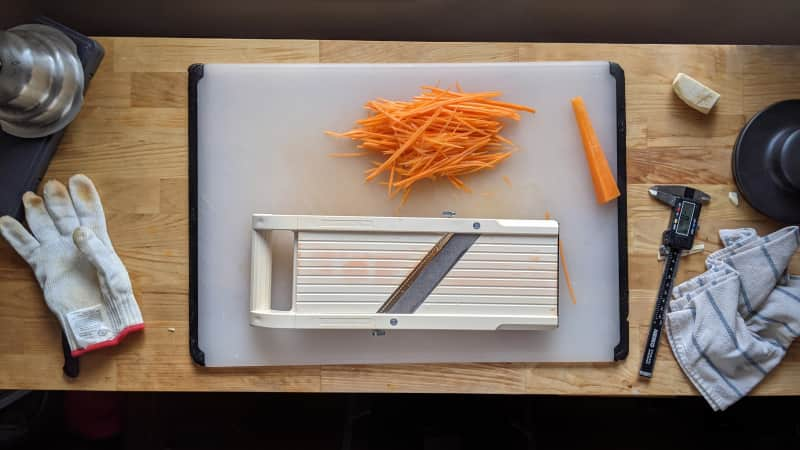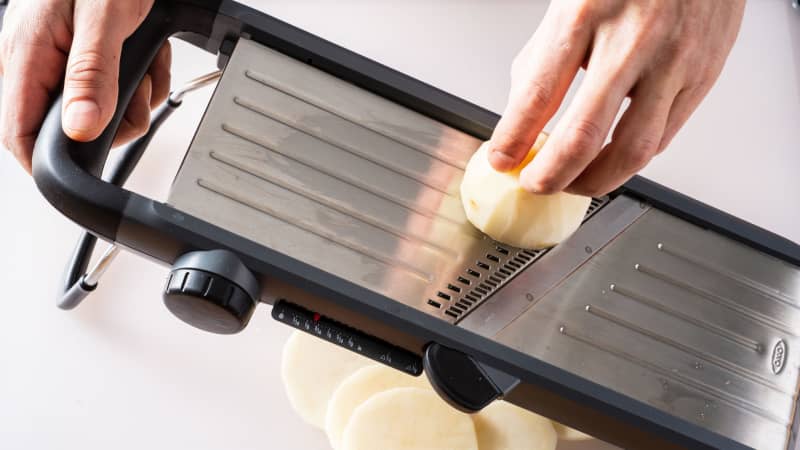Mandolines are somewhat notorious for being dangerous, and the combination of blades and moving food can indeed be risky if you don’t handle them properly. But to be fair, the same could be said of any bladed tool, whether it’s a knife or a grater. And as with knives and graters, we think that any mandoline can be used safely—as long as you exercise caution and good sense while using it. Here are a few tips we’ve picked up over the years that will help you use a mandoline successfully.
How to Use a Mandoline
Published Feb. 18, 2021.

Tip 1: Work on a Flat, Dry Surface.
This ensures that the mandoline will sit securely on the countertop; you don’t want it to move around on you as you slice, as this will increase the risk that your hands will also slip.
Tip 2: Use the Hand Guard—If It’s Any Good.
Many hand guards can’t protect you and securely hold food at the same time, but those that do are worth using.
Tip 3: Wear a Cut-Resistant Glove.

Not all mandolines come with good hand guards, and even the best guards can’t handle long pieces of food. For maximum safety, wear a cut-resistant glove on the hand you use to hold the food. The glove will provide a barrier between you and the blade, keeping your fingers safe.
Tip 4: Cut Foods in Half.

With many foods, especially round ones such as potatoes or apples, it’s a good idea to cut food in half so that you have a flat surface that can sit flat on the platform.
Tip 5: Slice at a Moderate Pace.
While it’s tempting to slice as quickly as you can to get through the job, you’ll have more control over the food—and your fingers—if you go at a slightly slower pace. Don’t go too slowly, though, or you won’t have enough momentum to push the food through the blade.
Tip 6: Position Food Toward the Side(s).

It might seem natural to slice food in the center of the mandoline, but most mandolines will slice more evenly if you position the food toward one side, as the platform is less likely to flex where the platform connects to the walls. On mandolines with diagonal blades, use your fingers to see where the platform is least flexible—usually it’s the side toward the top of the blade. Slice from there! On mandolines with horizontal blades, position the food on either side; consider alternating sides to help the blade wear evenly.
Tip 7: Clear Food from Under the Mandoline as You Work.
If sliced food builds up under the mandoline, it’ll obstruct the area under the blade, making it harder to push new food through all the way. As a result, food—or your fingers—can stop short and get jammed in the blade. So clear as you go.
Tip 8: Don’t Try to Force Food Through.
If the food gets stuck in the blade, don’t push harder or try to shove it through—the extra force can make you slip and slice your fingers. Instead, use the handle of a knife or a wooden spoon to gently knock the food back off of the blades. You can try to slice the food again from a different angle, rotating it slightly, but if the problem persists, your mandoline just isn’t capable of handling this food.
Tip 9: Sharpen Those Blades—or Replace Your Mandoline as Needed.
A mandoline has blades, and eventually, those blades will get dull. As the saying goes, a sharp blade is the safest blade. With some mandolines, including our co-winners, you can remove the blades for sharpening; a whetstone or professional sharpening service is best for this task. With mandolines that come with fixed blades, however, you will need to replace the whole unit. It’s not worth keeping a dull mandoline around; it’ll struggle to cut food but bite your fingers willingly.

